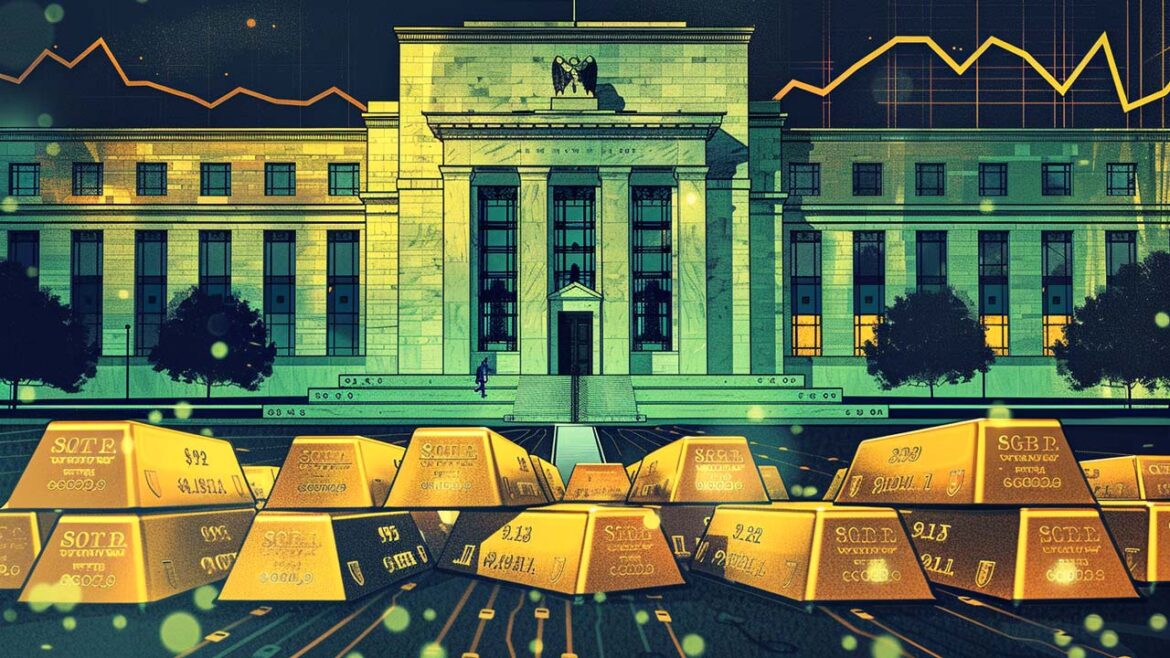Gold has all the potential to go unprecedentedly high. But silver will be gold on
Site:
Precious metals news
The World Gold Council has kicked off the 'You are Gold' campaign in India, targeting a fresh and youthful audience. This innovative multimedia initiative is designed to deepen the connection between millennials, Gen Z, and gold, casting the precious metal not just as a financial asset but as a symbol of personal empowerment and expression. It's a strategic move to align gold with the values of courage, perseverance, and the expressive identity of younger generations, thereby rejuvenating its appeal in a country with deep-rooted gold traditions.
 Massive Fed & Central Bank Money Printing Causing Tremendous Gold Producer Inflation As Barrick & Newmont Mining C...
Massive Fed & Central Bank Money Printing Causing Tremendous Gold Producer Inflation As Barrick & Newmont Mining C...February 26, 2024
It's truly astonishing to see how quickly the gold mining industry's costs have surged in the past few years. While several analysts blame the mining companies for being poorly run, the Fed and central banks are the real culprits...
The US economy is bloated. Years of massive spending and stimulus fed government bureaucracy and elites, but left behind record-high debt and stagnant income for everyone else. It's no wonder Americans don't see a healthy economy. Our guest commentator delves into this disconnect.
 METALS & ENERGY MARKET UPDATE FEB 25th: Natural Gas Market Still Heading To Record Lows & Something Big About To ...
METALS & ENERGY MARKET UPDATE FEB 25th: Natural Gas Market Still Heading To Record Lows & Something Big About To ...February 25, 2024
This is an IMPORTANT Update for several reasons. While discussing even more short-term "Bearish" fundamentals for Natgas, I see this as an opportunity, not a negative. Also, something BIG is about to Break in the Silver Market... but which way...
This week Peter covers the highlights of a volatile trading week, paying special attention to Nvidia, Wall Street’s favorite AI stock, and Newmont Corporation, a heavy hitter in the gold mining industry. Both companies’ shares experienced dramatic price action this week, with NVDA gaining $260 billion in market cap and pulling the market up after an excellent earnings report. Newmont, on the other hand, saw shares fall 7% after a disappointing last quarter.
The dream of retirement seems increasingly elusive for many younger Americans. A recent survey by the TIAA Institute revealing that about 21% of those aged 22 to 34 view retirement as either unattainable or not part of their life plan. This sentiment is understandable given the mounting challenges they face: the scarcity of decent entry-level jobs, the heavy burden of student loans, and the soaring cost of living. Social media platforms like TikTok are flooded with discussions about a "silent recession" or "silent depression," highlighting the struggle to afford basic necessities such as auto insurance, food, rent, and utilities...
Economists have recently updated their U.S. recession predictions, now estimating only a 40% chance, thanks to anticipated robust job market performance and solid consumer spending. This optimism is reflected in the revised economic growth forecast, which has been adjusted to a 2.1% annualized rate for this year, a significant increase from last month's 1.5% projection. This uptick is attributed to expected increases in household demand and government expenditure. Furthermore, consumer spending, a critical engine of the economy making up two-thirds of the GDP, is projected to rise by nearly 0.5% more than previously thought in the coming two years.
 The Growing Shadow of Credit Card Debt: A Crisis Looming Over American Consumers
The Growing Shadow of Credit Card Debt: A Crisis Looming Over American ConsumersFeb 23, 2024 - 11:41:49 PST
In 2023, the U.S. economy leaned heavily on consumer spending. Now, record-breaking credit card debt combined with soaring interest rates has catapulted delinquencies to new heights, signaling a burgeoning crisis in credit card debt. As these financial pressures mount, an increasing number of Americans are desperately seeking solutions. Data from Money Management International (MMI), a nonprofit credit counseling agency, reveals a significant spike in individuals seeking debt counseling post-holidays in January. This trend shows the urgent need to address and mitigate the growing credit card debt crisis.
Jurrien Timmer, Fidelity's Director of Global Macro, predicts Bitcoin's market capitalization could reach $6 trillion. His analysis, which was shared in a recent post, hinges on the premise that Bitcoin will increasingly be seen as a digital counterpart to traditional gold, serving as a dependable store of value.
In a shift from earlier market predictions, three leading brokerages have now set their sights on June for the anticipated U.S. Federal Reserve rate cut. The release of the Fed's January session minutes unveiled a palpable sense of uncertainty among officials, causing deep discussion on maintaining the current borrowing cost range of 5.25%-5.50% to achieve the central bank's inflation target of 2%.
Oil prices took a hit, falling over 2% as the Federal Reserve hinted at delaying interest rate cuts. With Brent crude futures tumbling down to $81.78 a barrel and U.S. West Texas Intermediate crude also taking a significant dip to $76.73, the oil market is bracing for a weekly downturn. Despite this week's fall, with Brent facing a 2% decrease and the U.S. benchmark poised for a 3% drop, there's a glimmer of hope. Signs of robust fuel demand coupled with looming supply concerns hint at a potential rebound in oil prices, offering a silver lining in the cloudy market scenario.
JD and Joel discuss Peter's take on the record-breaking highs in stocks, driven by chip company NVIDIA's $277 billion Thursday rally. Is there a stock bubble driven by AI hype and low-interest rates? How might the Fed respond and what does this mean for gold?
The US dollar's role as the global reserve currency is being challenged due to its use as a financial tool against countries like Russia and Iran. This has motivated nations, including the BRICS, to seek alternatives to the dollar, such as new international currencies and diversifying trade currencies, particularly in oil. While the shift away from dollar dominance is underway, a complete transition could take decades.
Economists are sounding alarms that the Federal Reserve might be on the brink of repeating past mistakes, this time by delaying interest rate cuts, potentially ushering in a recession. After admitting to being tardy in raising rates amidst the inflation surge of 2021 and 2022, the Fed now faces criticism for possibly acting too sluggishly as inflation begins to subside. Mark Zandi, chief economist at Moody's Analytics, warns of the increasing danger the longer the Fed hesitates to lower rates. With inflation gradually approaching the Fed's 2% target and economic risks mounting, Zandi advocates for a reduction in rates as early as March or, at the very latest, May.
The commercial real estate sector is facing a crisis, made worse by the pandemic's effect on office occupancy. Triggered partly by the 2008 Great Recession's low-interest rates, which fueled investments in real estate, the sector is now under strain as loans become problematic due to vacant buildings. This situation not only affects landlords and banks but could have broader economic implications.
The gold price has been surging, with unprecedented central bank demand gobbling up supply. It has been a force to behold — especially as US monetary policy has been relatively tight since 2022, and 10-year Treasury yields have rocketed up, which generally puts firm downward pressure on gold against USD.
ESG, or “Environment, Social, and Governance,” is the new feel-good buzzword in the halls of global corporations and megabanks. It’s a PR push to cloak morally disastrous firms in a veneer of social and environmental responsibility — lip service — but at the end of the day, I believe the market will speak.
 Argentina's Inflation Eases in Milei's Debut Month Amid Economic Overhaul
Argentina's Inflation Eases in Milei's Debut Month Amid Economic OverhaulFeb 22, 2024 - 13:52:46 PST
In President Javier Milei's first full month in office, Argentina saw a monthly slowdown in consumer price inflation to 20.6%, slightly below the anticipated 21%. Annually, inflation surged to 254.2%, marking the highest rate since the early 1990s post-hyperinflation period. Milei's economic measures, including a 54% devaluation of the peso and lifting price freezes, contributed to this trend. Despite these efforts, challenges remain, with expected continued annual price increases due to subsidy cuts and tax hikes.
The consumer price index continued to draw relatively weak response rates in 2023, calling into question the accuracy of the widely watched US inflation data.The share of completed surveys that were used in the CPI estimation stood at 71% in 2023, the Bureau of Labor Statistics said Friday. While that’s been ticking up in recent years, it’s still well below the pre-pandemic trend of near 80%.
Mortgage rates have risen above 7%, reaching a two-month peak and sustaining this level for over a week, indicating a potential shift in home affordability trends. This escalation reflects the highest rates since late November, with the average for a 30-year fixed loan now at 7.16%. The increase is making it even more difficult for many American's already struggling to afford housing.









